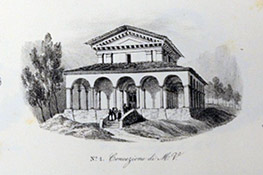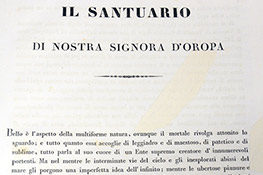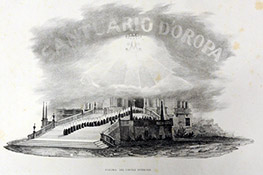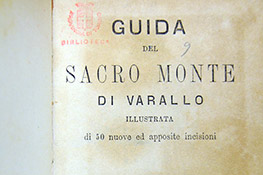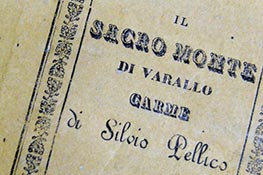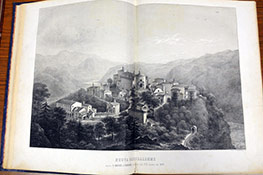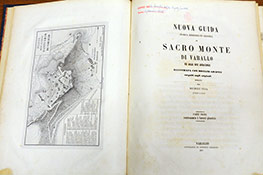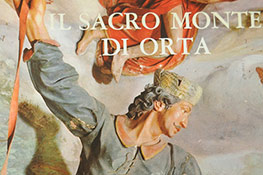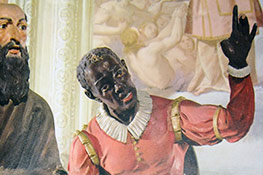Versione italiana English version Version française Versión en español
"The realization of a work of architecture and of holy art in a natural landscape, for didactic and religious scopes, reached its highest form in the Holy Mountains of the North of Italy, and it deeply influenced the next development of this phenomenon in the rest of Europe. The Holy Mountains of the North of Italy, realized for religious causes in a chritical period of the history of the Catholic Church, represent the seccessful integration between architecture and fine Arts in a landscape of great beauty":
by this motivation the Holy Mountains of Piedmont and Lombardy have been written in the list of Unesco World Heritage. Nine sites, composed by groups of chapels and other architectures, built between the '500s and '600s, integrated in a really beautiful natural landscape.
In Lombardy there are the Holy mountains of Varese and Ossuccio, In Piedmont the other seven: Crea, Belmonte, Oropa, Varallo, Orta, Domodossola and Ghiffa.
In the Historical Library it is possible to consult a rich documentation about the Holy Mountains, even some rare texts, like a book from the '500s, the Trattato dell'antichissima divotione nel Sacro Monte di Crea posto nel Ducato di Monferrato, dove Iddio ad intercessione della Beata Vergine opera continuamente molti miracoli, by don Costantino Masino from Vercelli (Pavia, 1590). About the sanctuary of Crea, composed by 23 chapels, built between '500s '600s and '800s, it is possible to consult also the Cenni sul Santuario di Nostra Signora di Crea in Monferrato (by Maurizio Clemente, Turin 1876) or the Brevi cenni storici sull'insigne Santuario di Nostra Signora di Crea (by Giuseppe Locarni, Casale 1900).
Begun in 1712, the realisation of th Holy Mountain of Belmonte, situated upon Valperga, was finished the following century. The complex includes a medieval sanctuary and 13 chapels dedicated to the Passion of Christ. Some bibliographic curiosities are: Breve storia del Santuario di Nostra Signora di Belmonte presso Valperga. Storia. Arte. Leggenda (by father Francesco Maccono, Casale Monferrato 1936).
Not distant from Biella, in a really beautiful 1200 metres high landscape, there is the Holy Mountain of Oropa, which is considered to be the most important Marian Devotional site in the Alpes area with its Black Virgin. Started in 1620, it is composed by 12 chapels dedicated to the Virgin's life. The library preserves a rare in-paper from 1830, Il Santuario di Nostra Signora d'Oropa, containing 12 lithographies by Enrico Gonin. There is also the Cenni storico-artistici intorno al Santuario di N. Donna d'Oropa by Maurizio Marocco (Turin 1866), dedicated to "candidi e discreti lettori".
It is maybe the Holy Mountain of Varallo that reaches the highest excellence of armony between art and landscape, it is placed in Valsesia, on a peak of rock at 600 metres upon the Varallo district. The architectural complex is composed by a cathedral and 45 frescoed chapels decorated by more than 800 statues. The building, begun in the 15th century, wants to reproduce in Valsesia the holy places of Palestine. The works by Tanzio da Varallo and by Gaudenzio Ferrari can be observed there.
Between the bibliographic rarities that can be consulted in the Library there is the Nuova guida storica, religiosa ed artistica al Sacro Monte di Varallo ed alle sue adiacenze (Varallo 1857) "illustrated with graphic drawings executed on the original" of the painter Michele Cusa. It is also interesting the Guida del Sacro Monte di Varallo, printed in Novara in 1874 and "illustrated with 50 new engravings". There are also asseys by Giovanni Testori about Gaudenzio Ferrari included in Il gran teatro montano (Feltrinelli 1965) and the carme Il Sacro Monte di Varallo by Silvio Pellico, "with Teresa Rachetti's typos see Caligaris (Varallo 1836). Curious and rare the little illustrated book published in London in 1928, Ex Voto, cured by Samuel Butler.
It is possible to find interesting material about the remaining Mountains, mostly related to Orta Mount, near the lake and dedicated to San Francesco. The building started from the end of the '500s and went on for two centuries. A volume with great illustrations is Il Sacro Monte di Orta, cured by Luigi Mallè (Turin 1963). There is also a small book printed in Novara in 1770, Descrizione semplice e succinta delle Sagre Cappelle erette sul Monte d'Orta. A register about Il Sacro Monte d'Orta nella storia e nell'arte, cured by Enzo Pellegrino, was published by Franciscan convent of Orta di San Giulio in 1982.

